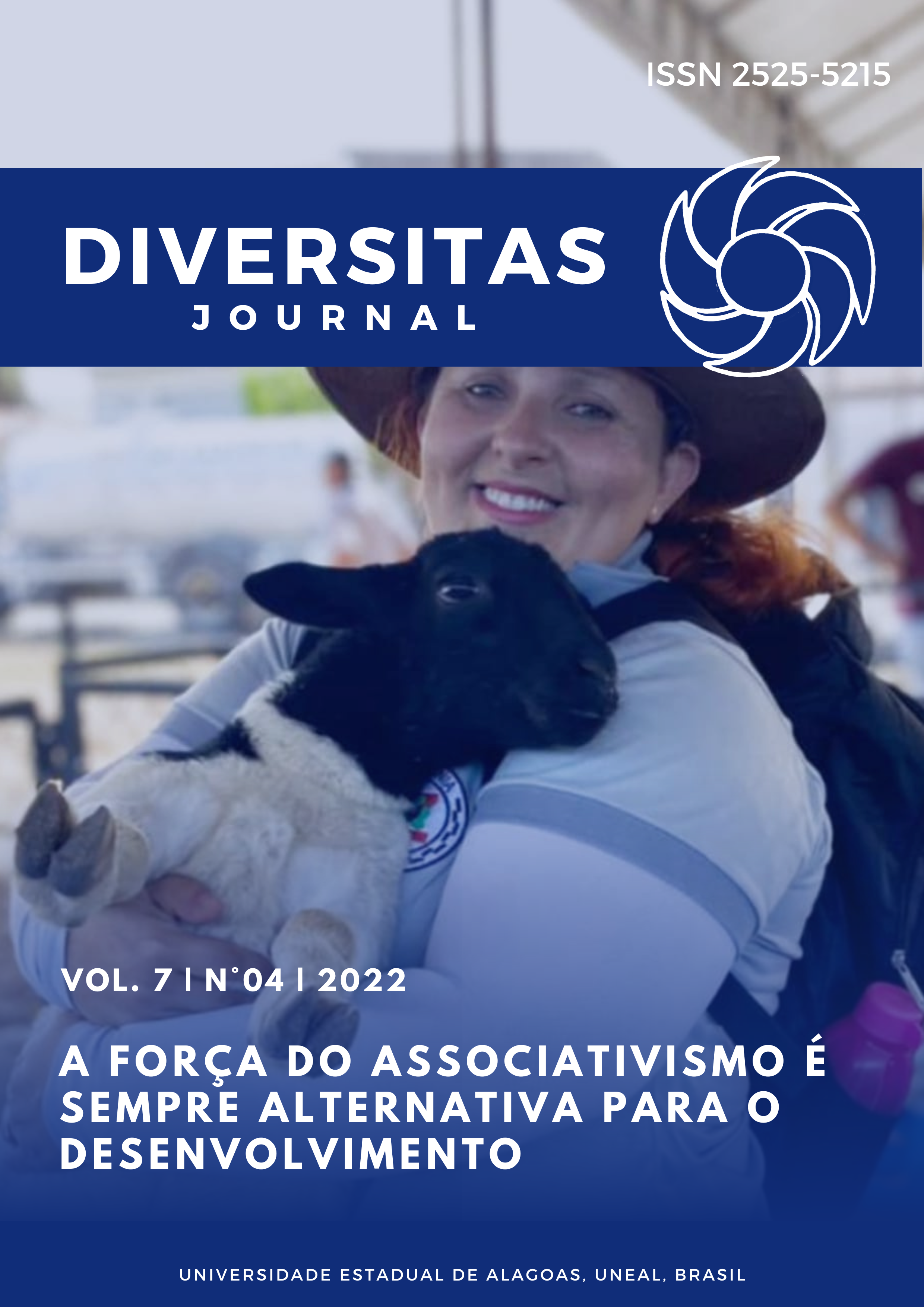Estoque e retenção hídrica da serrapilheira acumulada em plantios homogêneos de Mimosa tenuiflora (Willd) Poiret)
DOI:
https://doi.org/10.48017/dj.v7i4.2355Keywords:
Forestry, nutrient cycling, jurema-preta.Abstract
The accumulated litter is one of the bioindicators of programs for the recovery of degraded areas due to its importance in the biogeochemical cycle of forest ecosystems. Thus, this study aimed to evaluate the stock and water retention capacity of litter accumulated in six-year-old homogeneous plantations of Mimosa tenuiflora and different spacings (2 m x 2 m and 3 m x 3 m) in the municipality of Macaíba, RN. In each planting, 10 samples of the litter layer accumulated on the soil were collected through a metallic frame (template). The samples were separated into leaf and branch fractions, dried in an oven until constant mass and weighed on a precision balance to determine the stock. The water holding capacity of the litter was determined by the Blow Method. The average litter stock accumulated was 7,435.67 kg ha-1 for the smallest spacing and 7,943.11 kg ha-1 for the largest, with no statistical difference between the means. The leaf fraction constituted the largest proportion of accumulated litter. The water holding capacity was similar between the plantations, being 143.9% for the most dense and 143.1% for the other. The results reflect the potential of the species for the recovery of degraded areas in the region.
References
Alonso, J. M., Leles, P. S. S., Ferreira, L. N. & Oliveira, N. S. A. (2015). Aporte de serapilheira em plantio de recomposição florestal em diferentes espaçamentos. Ciência Florestal, 25(1), 1-11, 2015. https://periodicos.ufsm.br/cienciaflorestal/article/view/17439/pdf.
Alvares, C. A., Stape, J. L., Sentelhas, P. C., Gonçalves, J. L. M. & Sparovek, G. (2013). Köppen's climate classification map for Brazil. Meteorologische Zeitschrift, 22 (6), 711-728, 2013.
https://doi.org/10.1127/0941-2948/2013/0507.
Araújo, N. N. A., Santos Junior, H. B., Araújo, E. A. A., Souza, F. P., Andrade, V. M. S., Carneiro, F. S. & Oliveira, F. A. (2021). Estoque de nutrientes e retenção hídrica da liteira em três ecossistemas florestais da Amazônia oriental brasileira. Research, Society and Development, 10(1), e52510112083, 2021. https://rsdjournal.org/index.php/rsd/article/view/12083/10828.
Azevedo, S. M. A., Bakke, I. A., Bakke, O. A. & Freire, A. L. O. (2012). Crescimento de plântulas de jurema preta (Mimosa tenuiflora (Wild) Poiret) em solos de áreas degradadas da Caatinga. Engenharia Ambiental, 9(3), 150-160, 2012. http://ferramentas.unipinhal.edu.br/engenhariaambiental/
viewarticle.php?id=745&layout=abstract.
Back, J. (2017). Avaliação de projetos de recuperação de áreas degradadas implantados na região do médio Vale do Itajaí, Santa Catarina, Brasil. Revista Espacios, 38(54), 10, 2017. https://www.revistaespacios.com/a17v38n54/17385410.html.
Bakke, I. A. (2005). Potencial de acumulação de fitomassa e composição bromatológica da jurema preta (Mimosa tenuiflora (Willd.). Poiret) na região semi-árida da Paraíba. [Doutorado em Agronomia, Universidade Federal da Paraíba]. BDTD - UFPB. https://repositorio.ufpb.br/jspui/handle/tede/8108?locale=pt_BR.
Bakke, I. A., Bakke, O. A., Andrade, A. P. & Salcedo, I. H. (2006). Regeneração natural da jurema preta em áreas sob pastejo de bovinos. Caatinga, 19(1), 228-235, 2006. https://periodicos.ufersa.edu.br/caatinga/article/view/77/45.
Bendito, B. P. C., Souza, P. A., Ferreira, R. Q. S., Cândido, J. B. & Souza, P. B. (2018). Espécies do cerrado com potencial para recuperação de áreas degradadas, Gurupi (TO). Revista Agrogeoambiental, 10(2), 99-110, 2018. https://agrogeoambiental.ifsuldeminas.edu.br/index.php/Agrogeoambiental/article/view/1117/pdf_1.
Blow, F.E. (1955). Quantity and hydrologic characterstics of litter under upland oak forests in Eastern Tennessee. Journal of Forestry, 53 (1), 190-195, 1955. https://academic.oup.com/jof/article-abstract/53/3/190/4684864?redirectedFrom=fulltext.
Braga, R. S. (2022). Estoque e retenção hídrica da serapilheira acumulada em plantios homogêneos e em fragmentos de floresta nativa. [Trabalho de Conclusão de Curso em Engenharia Florestal, Universidade Federal do Rio Grande do Norte].
Caldeira, M. V. W., Sperandio, H. V., Godinho, T. O., Klippel, V. H., Delarmelina, W. M., Gonçalves, E. O. & Trazzi, P. A. (2020). Serapilheira e nutrientes acumulados sobre o solo em plantios de leguminosas e em área restaurada com espécies nativas da Floresta Atlântica. Advances in Forestry Science, 7(2), 961-971, 2020. https://periodicoscientificos.ufmt.br/ojs/index.php/afor/article/view/8310.
Chagas, K. P. T., Lucas, F. M. F. & Vieira, F. A. (2020). Predictive modeling of Mimosa tenuiflora (Willd) Poiret: how can climate change affect its potential distribution range? Revista Floresta, 50(2), 1315 - 1324, 2020. https://revistas.ufpr.br/floresta/article/view/62980.
Empresa de Pesquisa Agropecuária do Rio Grande do Norte (EMPARN). (2022). Meteorologia. http://meteorologia.emparn.rn.gov.br.
Ferreira, M. B., Bakke, O. A., Sousa, G. G., Bakke, I. A., Azevedo, S. R. V. & Ferreira, W. C. (2020). Spatial Distribution, Regeneration, growth and thicket formation of thornless Mimosa tenuiflora in a Caatinga site of Northeast Brazil. Journal of Experimental Agriculture International, 42(3), 137-149, 2020. https://journaljeai.com/index.php/JEAI/article/view/30491.
Ferreira, R. L. G., Lira Junior, M. A., Rocha, M. S., Santos, M. V. F., Lira, M. A. & Barreto, L. P. (2007). Deposição e acúmulo de matéria seca e nutrientes em serapilheira em um bosque de sabiá (Mimosa caesalpiniifolia Benth.). Árvore, 31(1), 7-12, 2007.
https://doi.org/10.1590/S0100-67622007000100002.
Freire, J. L., Dubeux Júnior, J. C. B., Lira, M. A., Ferreira, R. L. C., Santos, M. V. F. & Freitas, E. V. (2010). Deposição e composição química de serrapilheira em um bosque de sabiá. Revista brasileira de Zootecnia, 39(8), 1650-1658, 2010.
https://doi.org/10.1590/S1516-35982010000800005.
Godinho, T. O., Caldeira, M. V. W., Rocha. J. H. T., Caliman, J. P. & Trazzi, P. A. (2014). Quantificação de biomassa e nutrientes na serapilheira acumulada em trecho de Floresta Estacional Semidecidual Submontana, ES. Cerne, 20(1), 11-20, 2014. https://cerne.ufla.br/site/index.php/CERNE/article/view/954/728.
Machado, M. R., Piña-Rodrigues, F. C. & Preira, M. G. (2008). Produção de serapilheira como bioindicador de recuperação em plantio adensado de revegetação. Árvore, 32(1), 143-151, 2008. https://doi.org/10.1590/S0100-67622008000100016.
Mateus, F. A., Miranda, C. C., Valcarcel, R. & Figueiredo, P. H. A. (2013). Estoque e capacidade de retenção hídrica da serrapilheira acumulada na restauração florestal de áreas perturbadas na Mata Atlântica. Floresta e Ambiente, 20(3), 336-343, 2013.
https://www.floram.org/article/10.4322/floram.2013.024/pdf/floram-20-3-336.pdf.
Moreira, P. R. & Silva, O. A. (2004). Produção de serapilheira em área reflorestada. Árvore, 28(1), 49-59, 2004. https://doi.org/10.1590/S0100-67622004000100007.
Pinto, J. W. & Negreiros, A. B. (2018). A serrapilheira como bioindicador de qualidade ambiental em fragmentos de Eucalyptus. Revista Continentes, 7(12), 175-201, 2018. http://revistacontinentes.com.br/index.php/continentes/article/view/166.
Santana, J. A. S. & Souto, J. S. (2011). Produção de serapilheira na Caatinga da região semi-árida do Rio Grande do Norte, Brasil. Idesia (Arica), 29(2), 87-94, 2011.
https://www.idesia.cl/index.php?option=com_volumenes&view=d&aid=650&vid=45.
Santos, A. F. A., Carneiro, A. C. P., Martinez, D. T. & Caldeira, S. F. (2017). Capacidade de retenção hídrica do estoque de serapilheira de eucalipto. Floresta e Ambiente, 24(1), e20150303, 2017. https://www.floram.org/article/10.1590/2179-8087.030315/pdf/floram-24-e20150303.pdf.
Silveira, E. S., Reiner, D. A. & Smaniotto, J. R. (2014). Efeito do espaçamento de plantio na produção de madeira e serapilheira de Eucalyptus dunni na região Sudoeste do Paraná. Revista Técnico-Científica, 2(1), 1-9, 2014.
https://revistatecie.crea-pr.org.br/index.php/revista/article/view/41/28.
Souza, T. A. F., Rodriguez-Echeverría, S., Andrade, L. A. & Freitas, H. (2016). Arbuscular mycorrhizal fungi in Mimosa tenuiflora (Willd.) Poir. from Brazilian semi-arid. Brazilian Journal of Microbiology, 47(1), 359-366, 2016. https://doi.org/10.1016/j.bjm.2016.01.023.
Spain, A. V. (1984). Litterfall and the standing crop of litter in three tropical Australian rainforests. Journal of Ecology, 72(3), 947-961, 1984. https://www.jstor.org/stable/2259543.
Vargas, G. R., Bianchin, J. E., Blum, H. & Marques, R. (2018). Ciclagem de biomassa e nutrientes em plantios florestais. Pesquisa Aplicada & Agrotecnologia, 11(2), 111-123, 2018.
https://doi.org/10.5935/PAeT.V11.N2.12.
Villa, E. B., Pereira, M. G., Alonso, J. M., Beutler, S. J. & Lelés, P. S. S. (2016). Aporte de serapilheira e nutrientes em área de restauração florestal com diferentes espaçamentos de plantio. Floresta e Ambiente, 23(1),90-99, 2016.
https://www.floram.org/article/10.1590/2179-8087.067513/pdf/floram-23-1-90.pdf.
Additional Files
Published
How to Cite
Issue
Section
License
Copyright (c) 2022 Juliana Canto

This work is licensed under a Creative Commons Attribution 4.0 International License.
The Diversitas Journal expresses that the articles are the sole responsibility of the Authors, who are familiar with Brazilian and international legislation.
Articles are peer-reviewed and care should be taken to warn of the possible incidence of plagiarism. However, plagiarism is an indisputable action by the authors.
The violation of copyright is a crime, provided for in article 184 of the Brazilian Penal Code: “Art. 184 Violating copyright and related rights: Penalty - detention, from 3 (three) months to 1 (one) year, or fine. § 1 If the violation consists of total or partial reproduction, for the purpose of direct or indirect profit, by any means or process, of intellectual work, interpretation, performance or phonogram, without the express authorization of the author, the performer, the producer , as the case may be, or whoever represents them: Penalty - imprisonment, from 2 (two) to 4 (four) years, and a fine. ”


















